In a plethora of river cruise brands, Uniworld stands out for its flamboyance. Steve Hopkinson tries out Portugal’s Douro River on Queen Isabel.
This article was first published in April 2017, and updated in October 2024.
Many river cruise lines have found themselves trapped by the fact that locks and moorings mean all their ships have roughly the same dimensions. But that doesn’t mean they are all the same.
Uniworld, for instance, makes a big boast in describing its river fleet: “It isn’t often that the ship one travels on rivals the destinations. Yet this is more than true for Uniworld’s fleet of luxurious floating boutique hotels. Every Uniworld ship is a work of art.”
Flamboyant interiors, artworks on the walls and gigantic chandeliers are all hallmarks of this remarkable line.
Queen Isabel is smaller than most of the line’s ships. And while she is relatively restrained by Uniworld standards – she is owned by the Douro Azul company – she is comfortable and refined. Queen Isabel has since been replaced by Sao Gabriel, launching in 2021 and marking the first post-sailing after the pandemic.
We sailed on Queen Isabel through the UNESCO designated Douro Valley in Portugal and met the winemakers and others who have made this region famous.
We chose to make our own way from Lisbon to Porto, where our cruise began. The best part of getting around Portugal is its world-class motorways.
Lisbon to Porto is just over 300 kilometres and, by starting out early, we easily took in both Obidos, an ancient walled town with an amazing castle, and Coimbra, which has one of Europe’s oldest universities dating from 1290. Porto is also a stunning city.
We boarded Queen Isabel at about 4pm ready for our 5pm sailing and discovered a lot of our fellow passengers were loyal Uniworld cruisers. A good mixture of North Americans, Brits, Australians, New Zealanders and a few South Africans.
Staterooms and suites
Queen Isabel is petite, just 79 metres long by 11.5 metres wide. Her 59 cabins are fairly small, particularly in comparison with those on other Uniworld ships. However, those on the lower deck have large windows, and on the upper two decks, they have sliding doors and beautifully appointed balconies. Bathrooms are equipped with L’Occitane products and there is ample storage space.
Her lavishly appointed staterooms and suites have handcrafted Savoir of England beds with high-thread count Egyptian cotton sheets, and a pillow menu.
We tried a cabin on the main deck with a French balcony and an upper-deck suite. Our verdict: pay a little extra for the suite, for the extra space and the balcony.
Dining
Queen Isabel has an excellent restaurant and a small alfresco dining area. Breakfasts included a good selection, from fruit and cereal to eggs, bacon and a wonderful selection of freshly baked breads and pastries, along with cheese and cold cuts.
Before lunch and dinner, guests gathered in the main lounge for an update on activities and an introduction to the wine to be served with our meals. Every day, we were presented with new red and white varieties as we travel along the Douro. Portugal has been producing wine since the Romans arrived in the first century, so they’ve had a bit of practice to get it right.
Both lunch and dinner were hearty meals, such as roast leg of lamb, succulent pork, fantastic Portuguese fish dishes and aged beef. Desserts are suitably indulgent and, of course, the cheese selection is accompanied by port – what else?
One night was dedicated to a Portuguese Traditional Dinner. We started with poultry sausage and a wonderful kale, cabbage and chorizo Soup. The mains were a choice of bacalhau com broa (salted cod fish), gilled entrecote or grilled yellow pepper stuffed with vegetable rice, raisins and pine nuts. That left just enough room for a Portuguese trilogy of custard cream, cinnamon sponge and cooked pear in red wine, and of course cheese and wine. All washed down with wonderful wines from the region.
Cruising
After all that food, what better way to relax than with a little siesta in one of the comfortable sun loungers on the large sun deck, which has a small swimming pool.
We typically cruised for part of the day and the scenery along the way was amazing. Vineyards, small towns and fascinating architecture stretch along the river banks.
The influence of winemaking is everywhere. At Peso da Régua, we visited the Douro Museum with a port and wine experience, and the beautiful Mateus Palace. We headed up to the high peaks overlooking the river and vineyards for a wondering dinner at Quinta do Avessada.
At the Spanish border town of Vega de Terron, we visited Castelo Rodrigo, with its amazing history dating back to the Spanish Inquisition. The following day we ventured into Spain and the historical city of Salamanca.
On our return journey, we stopped at Pinhao to visit the world-class Sandeman Estate. The views were breathtaking and the port easy to drink. Back in Porto, a number of tours were on offer and there was a farewell dinner.
When is the best time to try the Douro? We like the European summer, as the days start early and the sun goes down at about 9.30pm. It feels as if the days never end.
However, the ship’s hotel manager, Peter, suggests visiting in late September and early October when the grapes are being harvested by hand.
Whenever you visit, cruising the Douro is a wonderful way to explore this part Portugal and see things from a different perspective. It is nice to know the region is a UNESCO World Heritage site, which will ensure it retains its uniqueness and charm.
The Verdict
Highs: Amazing scenery, food and the easygoing nature of the ship and crew makes for a wonderful week.
Lows: I would have liked more wine appreciation classes and perhaps a little more on the history-lesson front.
Best suited to: Those in their late 50s and over.







